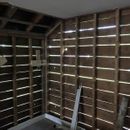WRB and air seal for aged board sheathing
Gut reno of 100 yr old build in zone 5. Two of the four exterior walls had to be stripped of the cedar clapboards and tar paper, leaving only the board sheathing. See the corner of these two walls meeting in the pic.
We intend the assembly outboard of the sheathing to be a WRB, drainage gap, then back on with clapboards (no exterior insulation). Inboard of the sheathing we intend to use mineral wool, smart vapor retarder, and skim coated wall board.
We are at the point that we need to pick a WRB which we also hope to serve as the air barrier. Gaps in the sheathing are substantial! Appreciate some guidance in the selection.
Thanks
GBA Detail Library
A collection of one thousand construction details organized by climate and house part










Replies
I had a similar dilemma during an addition and renovation of my house. I considered using Henry Blueskin, but since we were already using Zip R-sheathing on the addition, I decided to put new framing in plane with the existing sheathing (where needed), and cover the whole house in Zip R-sheathing. You can see the process midway in the attached photo.
Thanks Patrick. Did you go over the old boards with Zip R, or remove and replace them with Zip R?
Straight over! Attached a zoomed in crop.
Wooba,
Your two best options are either (1) OSB or plywood sheathing with taped seams (for example, Zip sheathing) -- note that this approach will help brace the walls, which horizontal board sheathing can't do -- or (2) a vapor-permeable peel-and-stick WRB like Blueskin VP160.
Thanks Martin. Blueskin has been mentioned to us a few times now. If we take the BS route, what are your thoughts for a drainage gap outboard of the Blueskin? We are not sure we can handle the full depth of BO Slicker, something more along the lines of Hydrogap was the drainage gap we were considering.
There's been rumblings that a self-adhered WRB with a drainage feature may be coming to market. I *think* Brian Pontolilo may have mentioned this here and/or on a podcast.
That would be a very interesting product for my application.
For similar structure, I went the peel and stick route. Did an excellent job of sealing the place up and was relatively quick to do. One area to watch is continuity of the air barrier near the ceiling, I ended up spraying the joint with one of the smaller 2 part foam kits.
Zip R would work just as well and significantly bump up your assembly R value. You are probably adding $2 to $3 /sqft in cost. You are in cold enough area that it could be worth it.
Rain screen is very simple to add on. You don't need a big gap, 3/8" strip of plywood nailed to the studs works well enough, the cost of one of the breather underlayments is not worth it.
PS Blue skin can be installed in vertical strips, much easier/quicker than going horizontal.
From one of several building professionals who are recommending BlueSkin for my patchwork sheathing. This pic from Nick at NS Builders ... which I believe is his family residence. Very similar to my sheathing issues. He is also using BO Slicker under his shingles. My drainage gap will be made with material TBD.
Nick also used closed cell spray in his 2x4 walls. I'll guess that was more for R value and not so much air seal (given the Blueskin on the outside)?
Here we go. The exterior wall assembly plan and start of the work. Still need to decide interior vapor retarder. As we are using mineral wool batts, I'm thinking Membrain (versus Intello+ or DB+)
If it were me, I wouldn’t use anything more than latex paint for a vapor retarder. Since you will have vented cladding, you are permitted to use a class III vapor retarder (e.g. paint).
https://cdn-web.iccsafe.org/wp-content/uploads/proclamations/TN06-Vapor-Retarders_pdf.pdf
Thanks Patrick. Several of the insulation estimates I have agree with you. The vapor control layer most confuses me. I get that hot-wet air meets cold-dry == condensing water ... to be avoided. But how that translated to my proposed wall structure ... I am confused.
I don't really have an opinion about whether a smart membrane is necessary or worth it, but I do think that one of the main advantages of intello over Membrain is that it's strong enough to hold dense packed cellulose. If you aren't doing that, then you can probably use the cheaper Membrain.